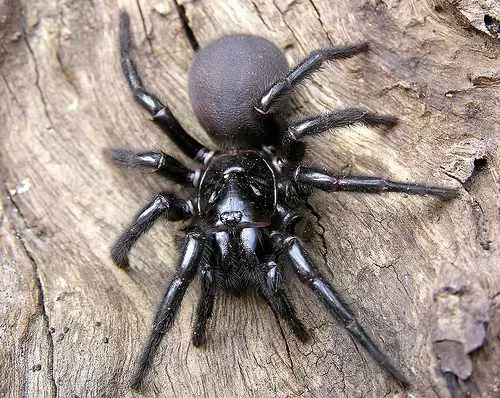The Top 5 Deadliest Spiders on Earth
| Spider | Location | Toxin Group | |
|---|---|---|---|
| 1 | The Brazilian wandering spider (Phoneutria keyserlingi) |
Central & South America | Ctenitoxin |
| 2 | Sidney funnel-web spider (Atrax robustus) |
Australia | Hexatoxin |
| 3 | Black widow spider (Latrodectus mactans) |
United States, Canada, Mexico, West Indies, South America | Theriditoxin |
| 4 | Brown recluse spider, Violin spider (Loxosceles reclusa) |
United States | Sicaritoxin |
| 5 | Redback Spider (Latrodectus hasselti) |
India, Indonesia, Phillipines, New Caledonia, Australia | Theriditoxin |
 Special Report
Special Report
What you'll discover in this report:
- Deadly spiders can mess you up, but are not so deadly after all.
- Deaths from spider bites are not that common.
- Who the baddest spider of them all is.
- Spiders are fugly, but kind of nice.
And much, much more...
The Trouble of Ranking Spiders for Top 5 Lists
It would be nice if it were easy to rank spiders into a nice and neat top 5 list but it isn't. It simply isn't easy to rank deadly spiders according to the "deadliest" spider or "deadliest venom" or "cutest spider" or whatever. For example, some of the same species of deadly spider can have different loads of spider venom, so one day they are number 1 out of the top 5 and another day they are number 2. Despite that fact, we did indeed rank them from one to five and you can be very sure that those spiders above on our list pack some pretty deadly venom. So it's best to run away screaming if you encounter one.
Spiders are Actually Pretty Cool
A lot of people hate spiders, which is quite a shame, because spiders are actually very interesting creatures. They are beneficial to us humans and of course to the entire natural ecosystem as a whole. According to the California Poison Control System, there are at least 50,000 species of spider crawling around on the earth somewhere. 10,000 of them are in your attic right now in fact. What makes a Spider a spider? Spiders are defined as having eight jointed legs, no wings, no antennae and only two body sections: the thorax and the abdomen. Spiders spend their entire life capturing and eating about 2,000 insects a year, and if most of those eaten insects are mosquitoes, we are fine with that.
It's an understandable fact that even though spiders do a great deal of good for our environment, spiders are greatly feared by most of the population. Probably because they are generally hideous creatures. Let's face it, if spiders looked like baby seals everyone would like them. Most spiders are killed only because they are ugly and scare people, not because they are actually dangerous to humans. A spider generally bites a human because it was scared and bites to defend itself. Spiders prefer to live in undisturbed areas such as in the corners of a house or in the garden where they can catch and dine on other ugly insects in peace.
Don't Mess With a Black Widow
Black Widow spiders are a deadly, venomous spider that are found in warm regions around the world. A black widow spider bite looks something like a target, with a pale area surrounded by a red ring. Severe muscle pain and cramps may develop in the first two hours. Severe cramps are usually first felt in the back, shoulders, abdomen and thighs. Other symptoms include weakness, sweating, headache, anxiety, itching, nausea, vomiting, difficult breathing and increased blood pressure. According to the CPCS, no person in the United States has died from a black widow spider bite in over 10 years (since 2000). Black widow spiders generally live in trash, closets, attics, woodpiles, garages and other dark places. Young children, the elderly and those with high blood pressure are at highest risk of developing symptoms from a black widow spider bite.
Luckily for us It's a Recluse
The brown recluse spider (Loxosceles reclusa) is named for its habit of hiding in dark corners, and is also known as the violin spider or fiddleback spider because of a violin-shaped marking. The spider is found mostly in the United States in southeastern Nebraska through to southern Iowa, Illinois, Indiana, Ohio, Texas, Georgia and Kentucky. Like all spiders the brown Recluse can be transported to other areas of the U.S. and to other countries.
The brown recluse spider bite usually causes some pain or burning in the first 10 minutes, accompanied by itching. The wound takes on a bull's-eye appearance, with a center blister surrounded by an angry-looking red ring and then a blanched (white) ring. The blister breaks open, leaving an ulcer that scabs over. The ulcer can enlarge and involve underlying skin and muscle tissue. Pain may be severe. A generalized red, itchy rash usually appears in the first 24-48 hours. Other symptoms include fever, chills, nausea, vomiting, muscle aches and hemolytic anemia (a condition where the red blood cells are destroyed). (A.)
Another Deadly Animal Living Down Under
According to the University of Sidney, the Sydney funnel web (and a few related Atrax species) is unquestionably the most dangerous spider in Australia. Of all the thousands of Australian spiders, arthropods and insects, only three have bites which alone are capable of causing death - the funnel-web spider (and related atrax species), the red back spider and the paralysis tick.
The Sydney funnel web spider is a large (6-7 cm), black, aggressive, ugly looking spider with massive fangs. When disturbed it tends to rear up on its hind legs, a defensive posture that exposes the fangs. They don't jump. During a bite the spider firmly grips its victim and bites repeatedly; in most cases the experience is horrific. The venom is highly toxic. Before an effective anti-venom was developed, significant bites usually resulted in severe symptoms and death. The venom of the slightly smaller male spider is five times as toxic as the female. For some reason, human beings (and other primates and monkeys) are particularly sensitive to the venom, whereas toads, cats and rabbits are almost unaffected.
This is What Happens when a Funnel Spider Bites You
First of all we suggest you don't get bitten by a Funnel Spider. If you're that unlucky however, The bite is usually immediately painful, and if the spider gets enough venom in you, symptoms start usually within a few minutes. The symptoms are progressive and they include: Piloerection (your hairs stand on end), sweating, muscle twitching, salivation, lacrimation (your eyes water continuously), tachycardia, and then severe hypertension. You're not finished yet though, because after all that follows vomiting, airway obstruction, muscle spasms, writhing, grimacing, pulmonary oedema and extreme hypertension. Then if you don't get help you will go unconscious, your intracranial pressure will raise (not good), you will have widely dilated pupils (often fixed), uncontrolled twitching, and lastly and finally, unless someone is there to give you CPR, you will die.
The Good News
On the positive side of being bitten by a Funnel Spider, there have been no reports of deaths when effective first aid had been instituted and, what is more, according to the Australian museum spider FAQ, the number of human deaths from authentic spider bites of any kind in Australia since 1979 has been zero (bees and wasps have caused far more deaths). A recent published medical study followed 750 genuine Australian spider bite cases with identified spiders over 27 months (1999-2001). Only 44 bites (6%, mostly redback spider bites) had significant effects. Only 6 redback bites and one Atrax bite were serious enough to need antivenom over this period. (B.) So Funnel Spiders are not all bad news.
The Baddest of All the Deadly Spiders
We don't mean to scare you, but the venom of a Brazilian Wandering Spider, a spider that from time to time has been found in bunches of bananas in countries far from Brazil, is 30 times more powerful than that of a rattlesnake. In fact they have the most active venom of any living spiders. Since 1926, 14 people are reported to have died from bites, however in 1996 an antidote was developed and no other deaths have officially been reported. Studies indicate only 33% of the spider bites actually contain any significant amount of venom.
The Phoneutria fera and Phoneutria nigriventer (two species of Brazilian wandering spider) are the two most commonly implicated as the most vicious and deadly of the Phoneutria spiders. The Phoneutria not only has a potent neurotoxin, but is reported to have one of the most excruciatingly painful envenoms of all spiders due to its high concentration of serotonin.
Brazilian Wandering Spider Venom has a Strange Side Effect
Now here's where things get a little weird, the Brazilian wandering spider venom can actually cause a penile erection for up to 2 hours. "The erection is a side effect that every man who gets stung by this spider will experience along with the pain and discomfort," said Romulo Leite, a researcher at the Medical College of Georgia. "We're hoping eventually this will end up in the development of real drugs for the treatment of erectile dysfunction." (D.)
So, in fact, while a spider bite can be serious, especially to small children, deaths from a spider bite are quite rare and your chances of dying from one is about one in ten bazillian (not an official number). Our friends down-under haven't had a death from a confirmed spider bite since 1979 (that is an official statistic). See? Spiders aren't so bad. They're pretty helpful little critters after all. Remember that when you try to squish them.

Noel James Riggs,
Owner and Head Writer, Top 5 of Anything.com.
Contact me at: njrtop5ofanything@gmail.com
Top 5 Special Reports Sources:
A. California Poison Control System (http://www.calpoison.org/public/spiders.html).B. The University of Sidney (http://www.anaes.med.usyd.edu.au/venom/spiders.html).
C. Myths about "Dangerous" Spiders; Burke Museum of Natural History & Culture. Various.
D. National Center for Biotechnology Information. (2010). Nitric Oxide-Induced Vasorelaxation in Response to PnTx2-6 Toxin from Phoneutria nigriventer Spider in Rat Cavernosal Tissue.
Sources: Top 5 of Anything Spider Research 2022.
List Notes: Important note: it is difficult to define exactly which spider in the world is the most dangerous to humans, therefore the list includes only spiders that have been known to cause human deaths. Exact figures for deaths or venom load for each spider is difficult or impossible to determine and thus this list should be considered as a rough ranking rather than an exact list of deadly spiders.

